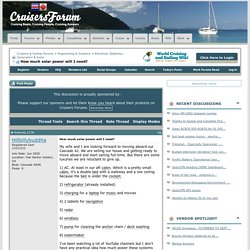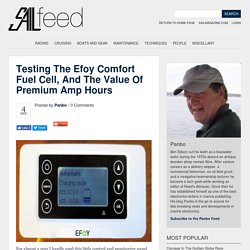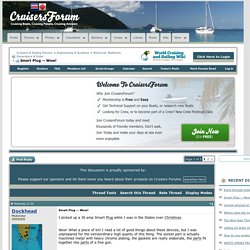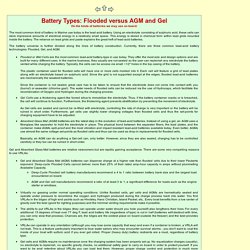

How much solar power will I need? - Cruisers & Sailing Forums. Quote: The 400w Panels I am looking at say their measurements are 79 inches x 39 inches.

If that measurement is correct, I can fit 2 on my dodger. It'll be tight but it'll fit. My mizzen boom does not extend over my transom so I figured I could put two panels over the back end/davits. But I haven't measured that, and I also want a hydrovaine, so that might not work. [QUOTE=chowdan;3228965] I have a single 350w LG panel that produces over 1kw a day(in PNW summer). I'm guessing I don't need 6 panels. [QUOTE=chowdan;3228965]As for your battery bank, adding that many batteries seems like a giant waste IMO. She already has the space built in. Relay for bildge pump - Cruisers & Sailing Forums. Quote: Hmm...I read it...I've re-read it...and I even referred to the real law (not an image of the placard) and electronically scanned for the word "automatic.

" Guess what...that word is not in the laws. Even the Federal Water Pollution Control Act (regulation) does not contain the word "automatic," and only 1 instance of the word "bilge. " BTW...the specific US Federal Law is 33 CFR Section 151.10 and 33 CFR Section 155. (33 CFR Section 155.450 is the specific section of the law that requires all boats over 26 feet to display a placard of at least 5x8 inches of the image you shared.)
Test comparatif eoliennes marine. Schma electoceanis43. Ten Deadly Conditions in Boat's Electrical Systems. These deadly electrical problems can affect even luxury boats like this one. By Tom Burden, Last updated: 4/4/2019 Blue Sea Systems’ engineering department has identified ten conditions that, when present in your boat’s electrical system, can cause serious problems. 1. Incorrectly sized wire There are several problems that occur when sizing wire for a boat’s electrical system using the ABYC 105°C tables: Using wire with less than 105°C insulation. However, usually wire size isn't a problem because: Most DC large loads are short term. The greatest concern here is with AC circuits that feed receptacles that can be easily overloaded. Even when using 105°C rated wire at its maximum current rating, the wire may be too hot to touch without burning yourself. 2. When matching circuit protection to the wire it protects, two facts contribute to the complexity of this task: Heat from high current can melt wire insulation and fuse blocks. 3. 4.
There is a downside to this green wire connection. 5. 6. 7. Discover Boating. Testing the Efoy Comfort fuel cell, and the value of premium amp hours - Sailfeed. For almost a year I hardly used this little control and monitoring panel because the attached EFOY fuel cell was already flawlessly performing its duty: If engine alternator, solar panels, and/or shore power were not keeping Gizmo’s main battery bank at the voltage parameters I’d configured, the EFOY automatically and quietly charged the bank for a variable period also configured.

While the amp hours are expensive — the tested 210 model retails for $5,899, and the company’s methanol fuel costs roughly $10 per 100ah — I’m convinced that an EFOY Comfort could be a very pleasing addition to many cruising sailboats and trawlers, especially as a complement to solar power. The installation, operation and EFOY economics are detailed further below, but first I’ll share a graphical use story. 24 Volt Electrical Systems. By Chuck Hawley, Last updated: 6/12/2018 The limits to 12 volt systems: Voltage drop Virtually all boats under 40 feet or so that have an electrical system operate at a nominal voltage of 12 volts.

That is, they use a battery that has a fully-charged potential of 12.6 volts, and the loads and charge devices that are installed on the boat are designed to operate between roughly 12 and 14 volts. Smart Plug. A great upgrade choice, DH.

I also converted to SmartPlugs 4 years ago and have had zero issues since. This boat came wired with dual 50A 125/250V [US] AC inlets [port and starboard- use the most convent one; only one is hot at a time...] Therefore I installed 2 of the 50A SmartPlug kits after having the usual issues with the original twistlock design. [I have read that the oritinal twist-lock design was first approved for use in the US in 1939... and is still the defacto standard today— for reasons unknown to me...] We have two shorepower cords with 50A SmartPlug ends. The lighter 30A cords [2 extensions on hand] are used mainly in summer [the 30A cord is easier to handle, and 30A is more than adequate when we aren't using the onboard A/C — heaters.] Choosing a Battery Charger for your Boat. Battery Types: Flooded versus AGM and Gel. On the kinds of batteries we may use on board: The most common kind of battery in Marine use today is the lead acid battery.

Using an electrolyte consisting of sulphuric acid, these cells can store impressive amounts of electrical energy in a relatively small space. This energy is stored in chemical form within lead grids mounted inside the battery. The reliance on lead grids and paste explains the great heft of lead-acid batteries. The battery universe is further divided along the lines of battery construction. Flooded or Wet Cells are the most common lead-acid battery-type in use today. Gel and Absorbed Glass Mat batteries are relative newcomers but are rapdily gaining acceptance. Gel and Absorbed Glass Mat (AGM) batteries can dispense charge at a higher rate than flooded cells due to their lower Peukerts exponent. Thus, there are some significant differences between battery types in terms of features and construction. Energy Storage per unit Weight and Volume.
Installing a Second Battery.